- Dr. Laurie Marker studies the intersection of cheetah ecology and human activities
- If we want to save the cheetah, we need to take what we know from research and apply it start linking landscapes and planning human development
- Improving electricity and internet coverage to Africa can create alternative livelihoods in rural communities and pay big dividends in reducing land pressure on wildlife
Laurie Marker’s passion for cheetahs was kindled far from the grasslands of Africa. In 1974, she got a job working for a new wildlife park in Oregon, and as she worked with the park’s captive cheetahs, her interest grew to their wild cousins back in Namibia. When Marker reached out to biologists and researchers, she quickly realized just how little people knew about the species, and decided to do something about it.
As the founder and executive director of the Cheetah Conservation Fund (CCF) in Namibia, Marker has essentially written the book on cheetahs, developing methods to re-introduce captive-bred animals, studying cheetahs’ habitat and movement patterns in the wild and discovering the species’ lack of genetic variation. She is now distilling the knowledge and insights gleaned in the past 25 years, developing strategies to solve the growing conflict between farmers and wildlife.
WildTech sat down with Marker to learn about how she got her start, CCF’s work with cheetah and human communities in Namibia, her views on the future of conservation and tips for aspiring field biologists.
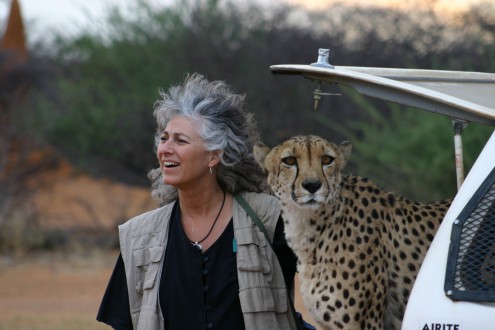
You pioneered a lot of the research to understand cheetahs and the factors at play in their conservation. Can you tell us about how you got your start working in the field?
Well I had been running a wildlife park and breeding cheetahs in captivity, but nobody really knew much about cheetahs in the wild and what was happening on the ground. Then we found out that farmers were killing cheetahs like flies, and the big dream in the ’70s was that we could breed them and they could go back to the wild. In the mid-’70s I ended up in Namibia to try and answer some of these questions, and that’s what got me involved in such a big way. I was in the Greater Waterberg Landscape, and my research question then was to find out if a captive-born cheetah could learn how to hunt. That’s the area where most [captive] cheetahs had originally come from, so it was a way of going back. As I went into Namibia there was a lot of space and not very many people, so I felt that the country gave us the best opportunity for conservation. And if we could develop strategies there, we could expand to other countries, which has been CCF’s strategy and what we’ve been doing now.
What are some of CCF’s current research questions and the conservation challenges you’re facing?
The question now after all the years doing research is “How do we apply what we learned?” They have huge home ranges and live in a very low density, which — with the way Africa and the rest of the world is going with so many people and the loss of habitat — means questions about how to apply land-use practices that are going to allow the cheetah and its prey base to live. That really revolves around solving human-wildlife conflict and looking at the needs of the people that are living on the land. Cheetahs don’t really do well in protected game reserves, so they are found outside of the reserves because they aren’t big enough for a cheetah’s home range. Their home ranges are about 800 square miles, so the parks just aren’t big enough. And lions and hyenas are in that area; they actually push the cheetahs out, which pushes them to land where there’s people. And people have lots of livestock, so we’re trying to look at how that really can change.
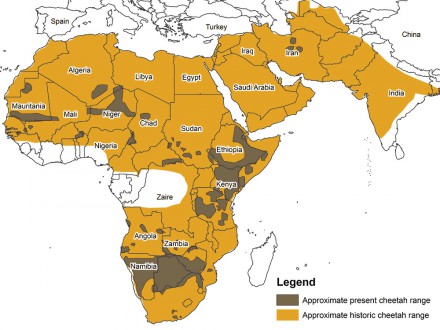
Thinking about cheetahs’ large home ranges and unique traits, do any of these characteristics make them easier or harder to study?
Well, they’re a diurnal cat, but they’re very shy and have been killed in the thousands, so they don’t just stand out and say, “Hey, I’m here!” Their habitat is in the thickened thorn bush, so they’re very hard to actually track and study on foot, and they just run away from everything. So they’ve been very, very difficult to study. All of what we’ve been able to learn is through forensics and tracking work. We caught and collared many cheetahs, and from that we really discovered everything: how they move, the ways they move. And satellite collars now have really improved this research.
With forensic analysis, we can look at what they are eating. Are they actually eating all of the farmer’s livestock? Actually, no, it was more of a perceived threat. By collecting their scat at trees used to mark territories, we were able to look at hair samples in the scat and find out exactly what they were eating. We came up with the cheetah’s entire list of prey throughout Namibia. This helped us show that incidents with livestock were extremely low. There are a lot of mysteries that the farmers just didn’t know, so you have to help them engage in better livestock and land management.
We would look at the animals that were catching livestock, finding out the problem: Was it the farmer or was it the animal? We found that, out of about 1,000 animals we worked on, less than three percent had actually caught livestock. Of that percentage, they either had some sort of medical problem like broken teeth or injury from a trap, or they were too young: They were cubs. Somebody had killed their mom, and they weren’t able to hunt on their own, so they were catching these animals. That kind of information was really important to share with the farmers because they thought all cheetahs were just out there wanting to eat livestock.
Can you talk more about the types of technologies you’re using with the cheetahs?
We used radio collars for years — going on 25 — but over the last 10 years, we started using satellite collars. That gives us a lot more information because data points are much more fine-scale. The cheetah’s have such a huge home range that it’s like 20 farms, or 10,000 hectares. When we used radio collars, we could only track them with a plane. With VHF collars, we were flying once or twice a week, but still you can’t see anything on the ground because the bush is too thick. The satellite collars give us a lot more fine-scale data. We tried using [GSM-based collars], but we didn’t have good enough reception to get the information from the collars. So of the cats we had with GSM, we had to catch all of them and get the collars back off to get the data. That was a long year is all I can say.
At one point, we were even thinking of making cell towers disguised as a play or marking tree, where the cats could come and upload their tracking information. We talked to some developers about doing that, but then satellite collars came out [and we started using those]. Again, it’s all been fairly opportunistic. We wanted to answer questions on home ranges and where they live: young males, dominant males, females. A lot of our work now has been focused on females.
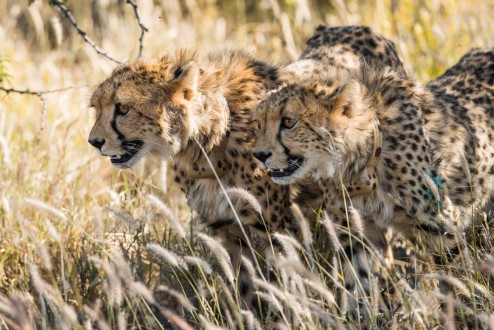
What techniques are CCF using to reduce the conflict between farmers and cheetahs?
We’ve been doing a lot of different things, like the guardian dogs and farmer trainings. We’ve now put out an app to start a citizen science study around the country of all of Namibia’s carnivores. But with human-cheetah conflict it’s been about looking at the people and how they manage their livestock. Do they have fences for them? Do they put their animals in the fences? Do they close the gate? And those are real simple things, but those are also the things that don’t occur with the farmers. For mitigation, the livestock guardian dogs are something we’ve been working on for 20 years, and they’ve been very successful not just with cheetahs but other predators, too. But with that you have to make sure the farmers have been trained properly and know what to do with the dogs, and they really work best with small stock.
We do a lot of this training in our farmer programs. We bring farmers to us and put them through a week’s-worth of training with everything from a classroom PowerPoint talk to actual hands on work with their livestock. We teach them how to know the sign of each predator and how the predators act. We also do a lot of work with simple livestock management. From a Western standpoint, some of this management might seem very simple, but for the people we’re dealing with it is quite complex — even figuring out how to trim hooves on their animals, or how to give vaccines or de-worm their animals. Or, how much grass does your cow need to eat? If you figure 25 hectares per one cow, when you’re a rural farmer you don’t really know what 25 hectares is. You might be sitting on one hectare, but you’ve got 25 cows. We actually go mark out how big their plot is, and we’ve got bags of grass that show them how much grass there is in a [good year], and so they start thinking about how many bags per each cow and realize they don’t have enough land for all of their cattle. We do simple things along these lines because a lot of the livestock are not very healthy due to poor management, and poor livestock is what causes more of the predation.
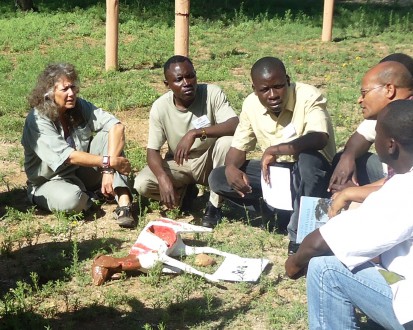
How do you see some of this work scaling, either in Namibia or across other parts of Africa?
We see it being able to scale, but a lot of it I think revolves around the fact that most people are subsistence farmers… and do subsistence farmers really want to be farmers? Are they farming for commercial business, or is that their livelihood? What we’re trying to do is to help people get out of poverty. The training that we’re doing now is actually going out into the villages and working directly with the communities. It’s like a scorecard — helping them with the report card, and then saying “Well, you know, here’s a problem. What could you do about this? What about that?” And then you figure out whether they can do it, and what their needs are if they can’t do it. Of course the other aspect in this level is to get people into different livelihoods, because there are a variety of different things people could do…The next level of scaling has been taking these trainings throughout the cheetah range countries with a lot of their biologists and their problem-animal scientists, and helping those countries develop similar programs. So that’s a scale up approach that could have broad perspective within Namibia and the continent.
So much of dealing with human-wildlife conflict is land use planning, and working with communities is essential for this large-scale approach. Do you see any technologies that have a role to play in this interaction between conservationists and communities?
Well yeah, gee, one big one would be electricity! Dun-da-da-dun! It bothers me a lot that most of the rural people in the world don’t have electricity because that’s going to keep everyone in poverty. It’s going to keep our landscapes in better shape if you can find alternative energy like solar or biomass, which we’re able to do at CCF with the Bushblok program. If we could get electricity, that then provides other opportunities for the villages, like storing vaccines and other medicines. We tend to forget about those aspects of people not having electricity. Having cell phone coverage has done a lot for Africa, but just think if everyone could get on Google every day. I mean those are things that we all take for granted, and yet that would provide so many different opportunities to build off of.
Basic access to these services can really help with population growth too. Africa’s population is supposed to double by 2050, and if the rural part of that population continues with the same livelihoods, we’re not going to have any place for cheetahs or elephants. If human population growth is out of control, and poverty is out of control, the wildlife is going to suffer. These are real, real serious things to think about.
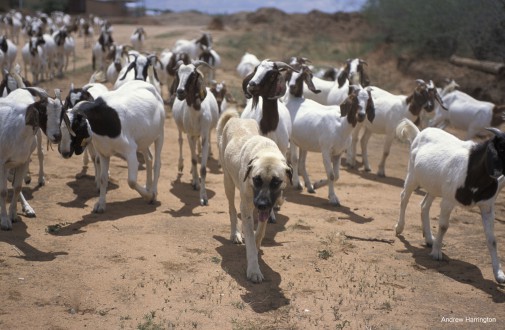
We try to end every interview with some tips from an expert. What advice can you give to aspiring field biologists?
As I mentioned, I think we need people to take what we know in many of these places and start to apply it. Especially with these long-ranging animals and all the other species that come underneath it, we need to think about how we actually make those linkages in large landscapes, so more of a land-use-planning mindset. I have to say that to young people who aspire to go out into the field: It’s wonderful to do [single species research], but now we really have to fine-tune the questions that we’re asking in the field and then trying to put these large landscapes into place, which will take a lot more detailed thinking. There may be more of a need for tech people and environmental economists, too. But as conservationists are laying these big-scale plans down, you still need to have people who know the sites and are on the ground monitoring the changes. If we want to save everything within a cheetah’s home range, we know that’s a whole landscape – some areas protected and some with human development – that has to come together, so it’s going to take a lot of interdisciplinary communication to make sure what you’re doing is working.
This interview has been edited for clarity and length.
